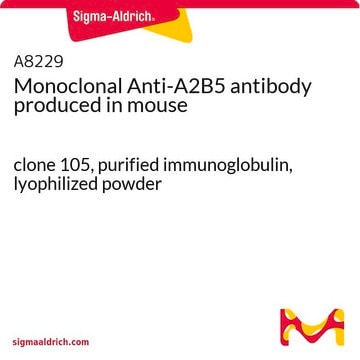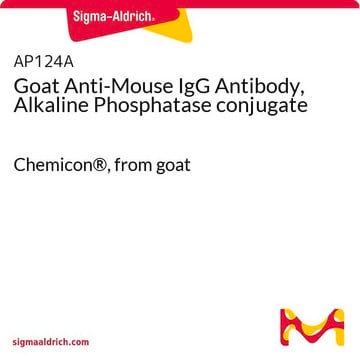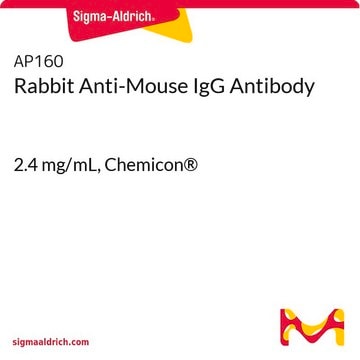MAB312R
Anti-A2B5 Antibody, clone A2B5-105
clone A2B5-105, Chemicon®, from mouse
Synonym(e):
Neuron Cell Surface Antigen
About This Item
Empfohlene Produkte
Biologische Quelle
mouse
Qualitätsniveau
Antikörperform
saturated ammonium sulfate (SAS) precipitated
Antikörper-Produkttyp
primary antibodies
Klon
A2B5-105, monoclonal
Speziesreaktivität (Voraussage durch Homologie)
mammals
Hersteller/Markenname
Chemicon®
Methode(n)
flow cytometry: suitable
immunocytochemistry: suitable
immunofluorescence: suitable
immunohistochemistry: suitable
Isotyp
IgM
Versandbedingung
dry ice
Posttranslationale Modifikation Target
unmodified
Allgemeine Beschreibung
Spezifität
Neurofibrillary tangles in the post-mortem brain tissue of patients with a confirmed diagnosis of Alzheimer′s disease (Majocha et al., 1989)
Neurons of chicken retina, brain, spinal cord, and dorsal root ganglia (Schnitzer & Schachner, 1982; Eisenbarth et al., 1979).
Rat striatal nerve terminals [synaptosomes (Wolf & Kapatos, 1989)].
Neuroblastoma cells in man (Oppedal et al., 1989; Coakham et al., 1985).
Rat insulinoma cells and pancreatic islets cells (Shimizu et al., 1983; Bartholomeusz et al., 1989).
Human and rat thymic epithelial cells (Haynes et al., 1988).
Cells involved in gliogenesis (Bottenstein et al., 1988; Suzumura & Slerberg, 1989).
Oligodendrocytes and astrocytes, type II (Dubois-Dalcq et al., 1990).
Immunogen
Anwendung
Neurowissenschaft
Neuronen- & Gliamarker
Complement-mediated cytotoxicity (Eisenbarth et al., 1979)
Flow cytometry: live cells {Maric, D. et al. (2000) Cerebral Cortex 10:729-747}.
Optimal working dilutions must be determined by end user.
Physikalische Form
Lagerung und Haltbarkeit
Hinweis zur Analyse
Type II astrocytes, human neural progenitors
Sonstige Hinweise
Rechtliche Hinweise
Haftungsausschluss
Sie haben nicht das passende Produkt gefunden?
Probieren Sie unser Produkt-Auswahlhilfe. aus.
Lagerklassenschlüssel
12 - Non Combustible Liquids
WGK
WGK 2
Flammpunkt (°F)
Not applicable
Flammpunkt (°C)
Not applicable
Analysenzertifikate (COA)
Suchen Sie nach Analysenzertifikate (COA), indem Sie die Lot-/Chargennummer des Produkts eingeben. Lot- und Chargennummern sind auf dem Produktetikett hinter den Wörtern ‘Lot’ oder ‘Batch’ (Lot oder Charge) zu finden.
Besitzen Sie dieses Produkt bereits?
In der Dokumentenbibliothek finden Sie die Dokumentation zu den Produkten, die Sie kürzlich erworben haben.
Unser Team von Wissenschaftlern verfügt über Erfahrung in allen Forschungsbereichen einschließlich Life Science, Materialwissenschaften, chemischer Synthese, Chromatographie, Analytik und vielen mehr..
Setzen Sie sich mit dem technischen Dienst in Verbindung.








